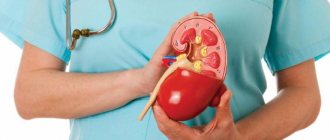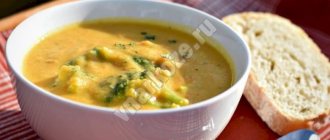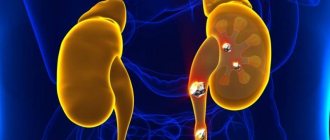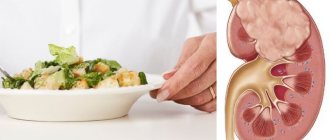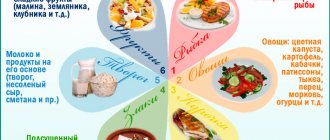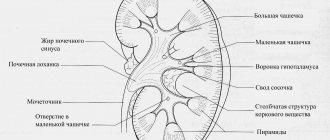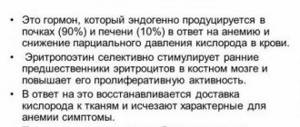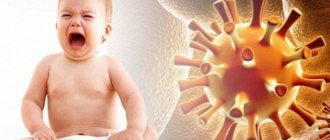Polycystic kidney disease is a pathology characterized by the formation of cysts on the kidneys. Diet for polycystic disease is an important process that affects recovery.
Thanks to the diet, the inflammatory reaction decreases, blood pressure normalizes, and the activity of developing cystic formations decreases. Each patient is selected a diet individually.
Diet principles
Doctors recommend that such patients adhere to the following dietary restrictions:
- Reducing salt intake. This is especially important for people with kidney failure, hypertension and edema.
- Minimize the amount of fatty foods in the menu.
- Reduce the amount of protein products, as their excess overloads the human liver and kidneys.
- Completely eliminate caffeine from your diet (tea, coffee, chocolate, etc.).
- Consuming an adequate amount of water per day is about 1.5 liters. With its excess, the load on the kidneys increases. It should be taken into account that these volumes include all liquids: teas, decoctions, broths, fruit drinks, juices and other drinks.
- Fractional diet: 5–8 meals a day in small portions.
- Avoid alcohol.
- Regular intake of vitamins, especially group B: they are involved in metabolism and stimulating the immune system.
Additionally, doctors recommend abstaining from cigarettes, nephrotoxic drugs (some antibiotics) and hormonal drugs during the diet. Doctors also advise even standing next to people who smoke.
It is necessary to control the blood pressure level, maintaining it within acceptable values of 120/80–130/90 mm Hg. Art.
Expected results from using the diet for polycystic kidney disease
Treatment of polycystic disease is aimed at preventing the progression of cyst growth and the occurrence of renal failure.
Diet therapy is designed to accomplish the following tasks:
- Provide the body with the necessary substances for full functioning.
- Facilitate kidney function.
- Help reduce arterial hypertension, urinary stagnation, and reduce swelling.
- Reduce the risk of kidney failure by eliminating nitrogenous compounds.
Doctors classify the treatment of this disease as symptomatic - aimed at eliminating complications and correcting the condition.
It is important to know! Along with medications and hemodialysis, a properly selected diet is an integral part of treatment.
Possible menu
For polycystic kidney disease, the diet includes the following foods:
- Vegetables: fresh, boiled or steamed.
- Fruits. Especially citrus fruits, pear, strawberry and kiwi.
- Lean meat and fish in small quantities.
- Fermented milk products. Unsalted cheese and low-fat cottage cheese.
- Cereal dishes Especially rye, lentils and barley.
- Seafood.
- Bran.
- Soups with vegetable broth.
- Weakly brewed tea.
- Mushrooms.
- Rice.
Delicious recipes
Lenten borscht. To prepare you will need 2 potatoes and carrots, 2 tomatoes and onions, 150 grams of cabbage, 1 beet and 1 tablespoon of tomato paste. First, peel and chop the vegetables, then fry the carrots and beets until half cooked in a frying pan, add onions and tomato paste to them, fry for 5 minutes. Then pour a glass of warm drinking water into the frying pan, cover with a lid and leave on low heat for 10 minutes. At this time, add water to the potatoes and let them cook. When it is almost ready, add vegetables from the frying pan and cabbage to it, leave covered for 10 minutes. Add finely chopped tomatoes to the borscht, leave on the stove for 3 minutes, then serve, sprinkled with chopped parsley.
Carrot and apple balls. Take 2 carrots and apples, 2 tablespoons of semolina, half a glass of milk and sour cream, 1 egg. Peel the carrots, grate them on a coarse grater, place them in a saucepan and add milk. Cook until half cooked and add semolina, mix thoroughly and leave to simmer covered for 15 minutes. At this time, peel and cut the apples in any convenient way, then add them to the mixture of carrots and semolina, add a little sugar and beat in the egg. Make small balls from the resulting mass, add sour cream and place in the oven at 180 degrees for 20 minutes.
Raspberry jelly. Take 200 grams of raspberries, 150 grams of sugar, 30 grams of gelatin. Pour cold water over the gelatin and leave at room temperature for 30 minutes, then drain the remaining liquid. While the gelatin is swelling, take care of the raspberries, wash and sort them. The raspberries are kneaded with a fork, drinking water is added to it, the mass is mixed and the juice is drained from it. Pour some hot water into the remaining raspberries and place on the stove, bring to a boil and cook for 5 minutes. Strain the mixture, add sugar, return to the stove, bring to a boil, remove the resulting foam and add gelatin. The previously drained raspberry juice is added to this mass, the liquid is poured into molds, cooled to room temperature and placed in the refrigerator for several hours. Before serving, the jelly is removed from the mold. If difficulties arise, you can dip the mold in hot water for 3 seconds, after which the jelly will come out of it without difficulty.
Diet for polycystic kidney disease is one of the mandatory measures for the control and treatment of pathology. Following a diet can reduce the risk of inflammatory processes and reduce or stop the growth of cysts in the kidneys.
Therapeutic nutrition normalizes blood pressure, which is also very important for polycystic disease. The menu should be developed by a specialist, since it is necessary to take into account the general condition of the patient and the presence of concomitant diseases.
Prohibited foods
In case of renal polycystic disease, it is necessary to exclude a number of foods that increase the load on the urinary system.
This list includes:
- Meat and fish broths.
- Alcoholic drinks.
- Smoked meats, canned food, sausages and various pickles.
- Semi-finished products.
- Coffee and strong tea.
- Sweets.
- Carbonated drinks.
- Mineral water.
- Certain types of cheeses: salty (brynza, suluguni, feta) and fatty (cheddar, Maasdam, Gouda, Russian, etc.).
- Potatoes (in any form!).
- Millet and semolina.
- Watermelons.
Depending on symptoms
If a patient has been diagnosed with a pathology of the excretory system, he needs to immediately change his diet to a more tolerant one. A diet for polycystic kidney disease is suitable for such patients. It minimizes the intake of harmful substances into the body that provoke affected organs and interfere with their normal functioning. Limiting the content of certain foods in the diet can reduce the load on the kidneys and liver, which prolongs their work. There are several types of therapeutic diets that can provide comfortable conditions for the kidneys and liver and relieve severe signs of the disease.
For this pathology, diet No. 7 is recommended. This diet for human polycystic kidney disease promotes normal kidney function, relieves tissue swelling and lowers blood pressure. There is no doubt that it is prescribed by a doctor after studying the patient’s test results. Because without his consultation it is impossible to find the optimal diet option. The fact is that the choice of one of the options for diet No. 7, of which there are several, depends on the observed symptoms:
- Diet No. 7-A is prescribed to a patient with polycystic kidney disease with dysfunction of the excretory organ. Its peculiarity is to reduce protein foods and eliminate salt. To prevent dishes from seeming too bland, you can use lemon juice for seasoning. In addition, with this diet it is necessary to limit liquid to half a liter per day and you cannot eat seafood, fish and legumes - peas, lentils, beans.
- Diet No. 7-B is not so strict - you are allowed to eat lean fish to replenish protein and 600 ml of liquid is already allowed.
- Diet No. 7-B is indicated for those who pass a lot of protein in their urine. To achieve balance, animal fats and a little salt (up to 2 g per day) are introduced into the diet. Liquids can be drunk 800 ml.
- Diet No. 7-G - prescribed to cleanse the blood. With this diet, potassium-containing foods are excluded, the amount of protein consumed should be within 60 g, minimum salt, and vitamin complexes.
Approximate diet
People suffering from polycystic kidney disease should also be careful about the amount of food they consume.
When choosing a diet, doctors recommend adhering to the following approximate limits for the amount of substances and calories per day:
| Main energy components | Valid values |
| Squirrels. | Up to 70 g. Moreover, 50% of them are of animal origin. |
| Fats. | No more than 90 g. 25% - vegetable. 75% are animals. |
| Carbohydrates. | 370–400 g. Sugar – maximum 80 g. |
| Calorie content: 2400–2500 kcal/day. |
IMPORTANT! These restrictions are very indicative, you should not follow them without first consulting a doctor!
Menu
For patients with polycystic kidney disease it may look like this:
- Breakfast: oatmeal with water. You can color the taste of a lean dish with 1 tsp. honey, various nuts or dried fruits.
- First snack. Ideally, this is some kind of fruit: banana, apple, pear, orange or kiwi. You can eat almonds, they are very high in calories, but nutritious and healthy.
- Dinner. The best option is proteins + carbohydrates in a ratio of 1:2. For example, boiled chicken fillet and vegetables - in the form of a side dish (broccoli, green beans, Brussels sprouts) or a salad made from them.
- Afternoon snack/second snack. Any fruit (except banana and grapes).
- Dinner. Proteins + carbohydrates in a 1:1 ratio. Boiled meat + vegetable side dish or cottage cheese.
IMPORTANT! The preferred drink is weakly brewed black tea.
Basic principles of diet therapy for polycystic renal disease
For successful treatment of the disease, it is important to adhere to the following rules:
- reduce protein intake;
- limit or completely eliminate salt from the diet, as well as spicy, fatty foods;
- do not exceed recommendations for drinking regime;
- enrich the menu with vegetables and fruits, cucumbers, tomatoes, and grapefruits are especially useful;
- meals should be fractional;
- Drink herbal teas recommended by your doctor.
Therapeutic nutrition allows you to stop the growth of cystic formations, relieve inflammation and remove swelling. But a specialist should develop the menu, since an incorrectly selected diet can aggravate the situation.
| Dried fruits with nuts | Buckwheat soup, rabbit meat, cabbage side dish, compote | Grapefruit | Casserole, skim milk | ||
| Tuesday | Egg omelet, chicory decoction | Rosehip decoction with oatmeal cookies | Lenten borscht, vegetable casserole, steam cutlet, jelly | Low-fat yogurt | Vegetable stew, weak green tea |
| Wednesday | Boiled rice, medicinal infusion | ||||
| Vegetable casserole | Okroshka, sweet pilaf, fruit drink | Banana | Buckwheat porridge, raisin-apple broth | ||
| Thursday | Hot sandwiches with unsalted cheese, rosehip infusion | ||||
| Fruit salad | Low-fat fish soup, rice, herbal tea | Apple | Vegetable casserole with raisins, medicinal infusion | ||
| Friday | Fasting day | ||||
| Saturday | Soft-boiled egg, bread, herbal tea | Dried fruit compote with croutons | |||
| Soup with rice, stewed veal with vegetables, salad, compote | Vegetable salad, cookies, fruit drink | ||||
| Sunday | Beet salad, medicinal infusion | ||||
| Rice pudding | White cabbage soup, chicken, pumpkin puree, chicory tea | Boiled beef with rice, herbal tea | |||
Vitamins
To combat any disease, it is not enough to just eat right, eat on time and follow a diet.
It is imperative to include complexes of auxiliary substances. Vitamins and minerals can be taken as medications or through food.
| Group of vitamins | Why are they needed? | Where are they kept? |
| A | They have a beneficial effect on the overall activity of the human kidneys. | Vegetables: carrots, bell peppers, broccoli, parsley, cilantro and onions. Legumes: soybeans, peas. Fruits: peaches, bananas, apricots, apples, grapes. Various berries. Animal origin: liver, milk, fish oil, caviar, butter, lactic acid products, eggs. |
| IN | Participate in the body's metabolism. | Cereals, meat, fish, eggs, almonds, mushrooms, broccoli, rice, corn, pear, beets and cauliflower. |
Authorized Products
Following a diet requires obtaining a full range of nutrients for the normal functioning of the human body, so the food must include vitamins. Authorized products are:
Recommended topic:
Causes of cysts in the kidneys
Cottage cheese
- lean meat;
- cottage cheese;
- seaweed;
- soy;
- mushrooms;
- rice and oatmeal porridge;
- grapefruit;
- cucumbers;
- grape;
- beans;
- kiwi;
- bell pepper;
- apples;
- celery;
- Brussels sprouts and white cabbage;
- tomato.
Main types of diets
The diet for polycystic kidney disease can have several variations. They depend on the severity of the disease.
| Table name | Diet | Excluded | Water | Calorie content |
| No. 7 A | Reducing the amount of protein. No more than 25 gr. | Salt, fish, meat, spices, herbs and legumes. | No more than 0.5 liters per day. | 2200 |
| No. 7 B | Protein up to 40 g, salt 0.5 g per day. | Cereals. | Up to 0.6 l per day. | 2400 |
| No. 7 B | Reducing the consumption of fats and simple carbohydrates (sweets and starch). Salt 2 grams per day. | Spices, spices. | About 0.8 liters per day. | 2800 |
| No. 7 G | Reduce protein to 60 g, salt to 2 g. | Up to 0.7 l. | 3000 |
Fully or partially limited products
- Limit or exclude salt (for kidney pathology). In this case, use salt-free bread and other baked goods.
- Salted and smoked products, fish caviar, canned fish and meat, canned vegetable marinades, chips, cheese, soup concentrates are excluded.
- Fried foods, animal fats and meat without prior boiling.
- Fatty fish and meat, any broths, legume decoctions.
- Onions, legumes, spinach, sorrel, radishes, garlic, radish, mushrooms, peppers, mustard, horseradish, ketchup.
- Strong coffee, any alcoholic drinks.
Table of prohibited products
| Proteins, g | Fats, g | Carbohydrates, g | Calories, kcal | |
Vegetables and greens | ||||
| vegetables legumes | 9,1 | 1,6 | 27,0 | 168 |
| sauerkraut | 1,8 | 0,1 | 4,4 | 19 |
| green onion | 1,3 | 0,0 | 4,6 | 19 |
| bulb onions | 1,4 | 0,0 | 10,4 | 41 |
| canned cucumbers | 2,8 | 0,0 | 1,3 | 16 |
| pickles | 0,8 | 0,1 | 1,7 | 11 |
| radish | 1,2 | 0,1 | 3,4 | 19 |
| white radish | 1,4 | 0,0 | 4,1 | 21 |
| turnip | 1,5 | 0,1 | 6,2 | 30 |
| celery | 0,9 | 0,1 | 2,1 | 12 |
| canned tomatoes | 1,1 | 0,1 | 3,5 | 20 |
| horseradish | 3,2 | 0,4 | 10,5 | 56 |
| garlic | 6,5 | 0,5 | 29,9 | 143 |
| spinach | 2,9 | 0,3 | 2,0 | 22 |
| sorrel | 1,5 | 0,3 | 2,9 | 19 |
Mushrooms | ||||
| mushrooms | 3,5 | 2,0 | 2,5 | 30 |
| marinated mushrooms | 2,2 | 0,4 | 0,0 | 20 |
Chocolate | ||||
| chocolate | 5,4 | 35,3 | 56,5 | 544 |
Raw materials and seasonings | ||||
| mustard | 5,7 | 6,4 | 22,0 | 162 |
| ginger | 1,8 | 0,8 | 15,8 | 80 |
| ketchup | 1,8 | 1,0 | 22,2 | 93 |
| mayonnaise | 2,4 | 67,0 | 3,9 | 627 |
| ground black pepper | 10,4 | 3,3 | 38,7 | 251 |
Meat products | ||||
| pork | 16,0 | 21,6 | 0,0 | 259 |
| salo | 2,4 | 89,0 | 0,0 | 797 |
Bird | ||||
| smoked chicken | 27,5 | 8,2 | 0,0 | 184 |
| duck | 16,5 | 61,2 | 0,0 | 346 |
| smoked duck | 19,0 | 28,4 | 0,0 | 337 |
| goose | 16,1 | 33,3 | 0,0 | 364 |
Fish and seafood | ||||
| dried fish | 17,5 | 4,6 | 0,0 | 139 |
| smoked fish | 26,8 | 9,9 | 0,0 | 196 |
| black caviar | 28,0 | 9,7 | 0,0 | 203 |
| salmon caviar granular | 32,0 | 15,0 | 0,0 | 263 |
| canned fish | 17,5 | 2,0 | 0,0 | 88 |
Oils and fats | ||||
| animal fat | 0,0 | 99,7 | 0,0 | 897 |
| cooking fat | 0,0 | 99,7 | 0,0 | 897 |
| * data is per 100 g of product |
Characteristics of the disease and dietary features
Polycystic kidney disease is a hereditary disease characterized by the formation of many cysts—cavities filled with fluid—in the kidney tissue. Such a lesion leads to a decrease in the volume of healthy tissue and a significant increase in the size of the organ due to cysts. With this disease, the kidneys become grape-shaped.
This renal pathology is expressed in the following symptoms:
- presence of blood in the urine;
- excessive urination;
- increased blood pressure;
- skin itching;
- an unquenchable feeling of thirst;
- weight loss and loss of appetite;
- weakness and excessive fatigue;
- attacks of nausea and bowel dysfunction.
Attention! When treating polycystic kidney disease, table N7 is recommended. The diet involves limiting the consumption or completely eliminating certain foods. Its essence is to reduce the load on the kidneys, blood pressure and reduce swelling. By changing the diet, toxic substances are removed from the body, the elimination of which was slowed down due to impaired kidney function.
Diet principles for patients with polycystic disease:
- reducing animal protein consumption;
- salt restriction;
- reducing the amount of fluid you drink;
- exclusion of spices,
- complete rejection of spicy and fatty foods;
- small and frequent meals;
- compliance with calorie intake;
- giving up bad habits (smoking and alcohol).
Diet chicken salad
Ingredients: boiled chicken 500 g, boiled potatoes 2 pcs., 3 pcs. cucumbers and boiled eggs, olive oil, lemon juice, tomato paste - 1 tbsp. l., greens. Peel the skin and remove the bones from the chicken, cut into small cubes, do the same with the potatoes and eggs, mix. Mix olive oil with lemon juice and pour over the salad. Decorate with greens.
Cheese casserole
This is a great dessert for those who suffer from polycystic kidney disease. To prepare you will need: half a kilogram of low-fat cottage cheese, 2 tbsp. spoons of honey and 2 tbsp. spoons of semolina, berries (optional, to your taste), 1 tbsp. l. low-fat sour cream. First, combine semolina with sour cream, leave for 10 minutes. Beat eggs into another container, add cottage cheese, stir. Transfer the curd mixture to the semolina and stir. Add berries, stir. Place in a preheated oven to bake for about 30 minutes.
